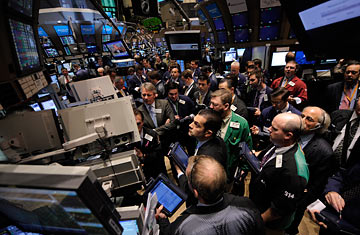
Traders gather near the trading posts for both Ford's and the CIT Group's stocks at the New York Stock Exchange
Stocks rise, the dollar falls and unemployment continues to worsen. How should investors make sense of the crosscurrents and what should they do with their money? To get a sense of the market's prospects, TIME spoke with Kirk Hartman, chief investment officer at Wells Capital Management, the investment division of Wells Fargo bank, with about $370 billion under management.
What do you make of the stock market's rise and the dollar's fall?
I'm optimistic on the market. I think the economy has caught a huge break with low interest rates, which are really going to make a difference. While the weaker dollar is obviously a concern, it's helping exports to remain strong. At the end of the day, though, it's low interest rates that matter more to the stock market.
But is this rally just reflecting the government's huge stimulus?
The recovery in the stock market is really a function of the fact that corporate profits continue to be pretty strong, and that's because there is low wage pressure and, overall, companies have done a pretty good job of running efficiently.
As for the stimulus, we are in a slow recovery environment, but the fiscal and monetary stimulus is obviously having a positive impact.
There's another point I'd mention: There's a lot of cash on the sidelines, both at the individual level and the institutional level. At some point, all this cash has got to go to work, and I think that's what you're seeing [in the market rally.]
What do you make of the fact that bonds have rallied, a bet on deflation, while commodities have also rallied, a bet on inflation?
There's still a lot of risk aversion among investors, which is why the bond market is so strong. In other words, if you are fearful of stocks, you're just going to stay in the fixed-income market. But we are in a low-yield environment now, so those same investors — individuals and investment managers — are reaching out for riskier assets to get more yield. That's why you see things like junk bonds rallying. You also see commodities rallying — but that's also an expression of risk aversion. People see stocks as too risky, but they still want return.
Where do you see market vulnerabilities?
Near term, I don't think you're going to see much change. I think you'll see both fixed-income and commodities markets continue to be strong.
Longer term, because of the tremendous government borrowings, we are eventually going to have an inflation problem, and that means a bond-market sell-off down the road.
Are we talking in the next six months or much longer?
I think we're talking 18 months, maybe two years down the road. People are still talking about deflation; you're still looking at low labor costs, high unemployment and a slow recovery. Inflation will probably come, but not for a while.
What's the outlook for commodities like gold?
Risk aversion will continue, and that means continued interest in commodities. Gold will be strong but, interestingly, not because of inflation but because as the dollar gets weaker, people want someplace safe to put their money, and right now they view gold as more stable than the dollar.
For investors who are willing to venture into stocks, what parts of the market look most promising?
The rally has more to go, maybe another 10%. Within that, what's interesting from my perspective is this: Across our organization we have a much larger weighting in technology. Probably 8 out of 10 top holdings are technology stocks, while a few years ago it was financial stocks. Overall, our managers see value generally in growth stocks, and specifically in technology.
